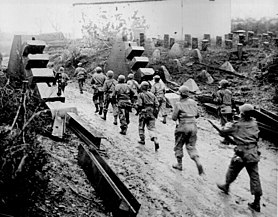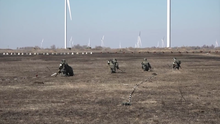This is an old revision of this page, as edited by Citation bot (talk | contribs) at 03:12, 15 March 2023 (Add: authors 1-1. Removed parameters. Some additions/deletions were parameter name changes. | Use this bot. Report bugs. | Suggested by AManWithNoPlan | #UCB_CommandLine). The present address (URL) is a permanent link to this revision, which may differ significantly from the current revision.
Revision as of 03:12, 15 March 2023 by Citation bot (talk | contribs) (Add: authors 1-1. Removed parameters. Some additions/deletions were parameter name changes. | Use this bot. Report bugs. | Suggested by AManWithNoPlan | #UCB_CommandLine)(diff) ← Previous revision | Latest revision (diff) | Newer revision → (diff) Pyramidal anti-tank obstacles For other uses, see Dragon's teeth (disambiguation).| This article needs additional citations for verification. Please help improve this article by adding citations to reliable sources. Unsourced material may be challenged and removed. Find sources: "Dragon's teeth" fortification – news · newspapers · books · scholar · JSTOR (January 2010) (Learn how and when to remove this message) |

Dragon's teeth (Template:Lang-de) are square-pyramidal fortifications of reinforced concrete first used during the Second World War to impede the movement of tanks and mechanised infantry. The idea was to slow down and channel tanks into killing zones where they could easily be disposed of by anti-tank weapons.
They were employed extensively, particularly on the Siegfried Line.
World War II
Dragon's teeth were used by several armies in the European Theatre. The Germans made extensive use of them on the Siegfried Line and the Atlantic Wall. Typically, each tooth was 90 to 120 cm (3 to 4 ft) tall.
Land mines were often laid between teeth, and further obstacles were constructed along the lines of teeth, such as barbed wire to impede infantry or diagonally-placed steel beams to further hinder tanks. Many were laid in the United Kingdom in 1940–1941, as part of the effort to strengthen the country's defences against a possible German invasion.
Behind minefields were the dragon's teeth. They rested on a concrete mat between ten and thirty meters wide, sunk a meter or two into the ground (to prevent any attempt to tunnel underneath them and place explosive charges). On top of the mat were the teeth themselves, truncated pyramids of reinforced concrete about a meter in height in the front row, to two meters high in the back. They were staggered and spaced in such a manner that a tank could not drive through. Interspersed among the teeth were minefields, barbed wire, and pillboxes that were virtually impregnable by the artillery and set in such a way as to give the Germans crossing fire across the entire front. The only way to take those pillboxes was for infantry to get behind them and attack the rear entry. But behind the first row of pillboxes and dragon’s teeth, there was a second, and often a third, and sometimes a fourth.
Due to the huge numbers laid and their durable construction, many thousands of dragon's teeth can still be seen today, especially in the remains of the Siegfrieds.
-
 World War II dragon's teeth at Fairbourne Beach, Wales, in 2009, designed to stop tanks landing
World War II dragon's teeth at Fairbourne Beach, Wales, in 2009, designed to stop tanks landing
-
Dragon's teeth on GHQ Line near Waverley Abbey, Surrey in 2006
-
 United States Army troops passing through dragon's teeth on the Siegfried Line in 1944.
United States Army troops passing through dragon's teeth on the Siegfried Line in 1944.
-
Dragon's teeth from the Alpine Wall
Post World War II
The term has survived into the present day and can be used to describe a line of posts or bollards set into the ground to deter vehicle access, for example in rural car parking areas or alongside roads.
Some stages of Rallye Deutschland, the German round of the WRC rally championship, are run on roads belonging to the military training ground at Baumholder. The roads are lined with dragon's teeth, known as "Hinkelsteine". They usually serve as obstacles to prevent tanks from leaving the roads, and cause significant damage to any rally car which veers off track.
By country

- Switzerland continues to maintain lines of dragon's teeth in certain strategic areas. In military jargon, these constructions can be referred to as "Toblerone lines", after the chocolate bar.
- Korea - Dragon's teeth are present in some areas along the Korean Demilitarized Zone borderline.
- Germany - They were used on the East German side of the Berlin Wall.
- Yugoslavia - Some countries after the breakup of Yugoslavia have movable teeth, positioned at roadsides at strategic locations, which can be lifted and placed on the roads.
- Russia and Ukraine - In Belgorod Oblast, defensive lines of dragon's teeth were constructed in October 2022 under the supervision of the Wagner Group along the Russia-Ukraine border, intended as a second line of defense alongside trenches and a trained militia in the event Ukrainian armed forces break through the Russian border in the Russo-Ukrainian war. A series of dragon's teeth fortifications named the Wagner Line [ru] have also been built by the Wagner Group in Russian-occupied Hirske in Luhansk Oblast. The Wagner Group aims to complete the Wagner Line in Russian-controlled Ukrainian territories as far east as Kreminna and as far south as Svitlodarsk.
See also
- Caltrop
- Czech hedgehog
- Dragon's teeth (mythology)
- Jersey barrier
- Spike strip
- Toblerone line
- Wave-dissipating concrete block
References
- Wilson, Joe (1999). The 761st "Black Panther" Tank Battalion in World War II. McFarland. p. 150. ISBN 0786406674.
This section of the Siegfried Line sat in the middle of the Hardt Mountains, where the landscape was dotted with pillboxes and dragon teeth tank obstacles.
- Bohner, Roy. "Baptism of Fire on the Siegfried Line". 11th Armored Division Legacy Group website. Retrieved 26 February 2013.
it was late afternoon on 18 Feb when passed through the Siegfried Line dragons teeth
- Owens, Emiel W. (2006). Blood on German Snow: An African American Artilleryman in World War II and Beyond. Texas A&M University Press. p. 56. ISBN 1585445371.
Human-made obstacles such as the "dragon teeth" were integrated carefully into the defense system of the line.
- Ambrose, Stephen (1998). The Victors: Eisenhower and his Boys — The Men of World War II. New York: Simon & Schuster. pp. 256. ISBN 9780684856285.
- "Rally Germany 2004 Petter Solberg's Huge Hinkelsteine Crash". YouTube. Retrieved 2022-03-04.
- Grundhauser, Eric (20 April 2015). "Toblerone Line". Atlas Obscura. Retrieved 24 October 2022.
- Park, Kyung-man (29 September 2019). "The antitank barricades that dot the landscape in border towns near DMZ". The Hankyoreh. Retrieved 24 October 2022.
- "Wagner Group founder claims that Russia creates defensive lines, 'people's militia' in Belgorod Oblast". Kyiv Independent. 19 October 2022. Retrieved 23 October 2022.
- Mezzofiore, Gianluca; Murphy, Paul P. (22 October 2022). "Russian mercenary group constructs anti-tank fortification, satellite images show". CNN. Retrieved 23 October 2022.
- Hernandez, Marco; Holder, Josh (2022-12-14). "Defenses Carved Into the Earth". The New York Times. ISSN 0362-4331. Retrieved 2022-12-14.
External links
- The Toblerone trail
- Dragon's Teeth in Horsham, West Sussex
- "You Build 'Em - We'll Bust 'Em." Popular Science, June 1942, pp. 106–112. Field expedient tank traps constructed of logs.
- White Cliffs Underground - Dragon's Teeth and Tank Traps around England's south coast
- Dragons Teeth on Libyan border with Egypt
- "Anti-Tank Obstacles, Isle of Grain, Kent - English Heritage". English Heritage. 2012-12-23. Archived from the original on 2012-12-23.